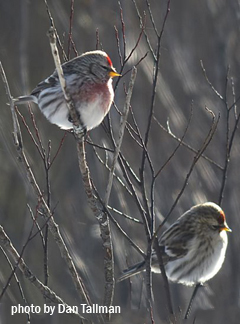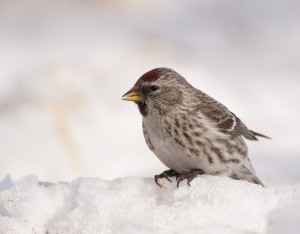
 Identification
Identification
The Common Redpoll is a tiny, fluffy finch that is most often only encountered during the winter by backyard birdwatchers. Related to goldfinches, Common Redpolls are similar in size at about five inches long but with a more compact profile and a small conical bill. Their chests and sides are white with brown streaks, they have some light streaking on their brown backs, two white wing bars, and pale undersides. The name redpoll refers to the red cap they have on their forehead. You can identify between male and female redpolls by the pink wash males have on their chests (it looks a bit like a Purple Finch’s chest markings, sometimes paler).
The closely-related Hoary Redpoll (Carduelis hornemanni) breeds farther north than the Common Redpoll and is identified by a much paler streaking and little if any red color on the breast. Small numbers of Hoary Redpolls sometimes mix with flocks of Common Redpolls during winter.
Range and Habitat
Common Redpolls breed in the far northern boreal forests and taiga regions of Alaska and Canada. This is a circumpolar species, meaning they can be found in similar habitat in northern North America, Russia, and Scandinavia. During the winter, redpolls may move south into southern Canada and the northern half of the United States. This movement, also known as an irruption since it’s not a true annual migration, is prompted by food availability and weather. Redpolls seem to irrupt on an every-other-year pattern but the size and distance fluctuates, some years reaching only Southern Canada, New England, and far northern parts of the Midwest, other years extending farther south throughout the Midwest and Mid-Atlantic states. They will winter in open scrubland as well as suburban areas.
Attracting
Redpolls eat many types of small seeds such as birch and alder, grasses and willows. During breeding they will supplement this seed diet with small insects. In winter backyards they are most often seen at or below finch feeders eating Nyjer®. Look carefully at your flock of winter finches: they are often mixed in with goldfinches and Pine Siskins.

